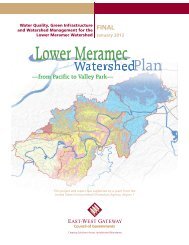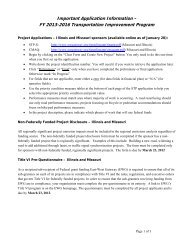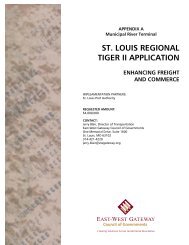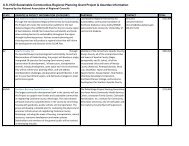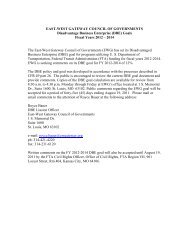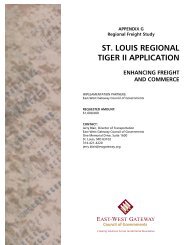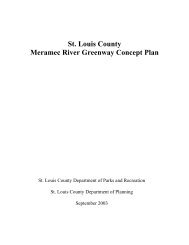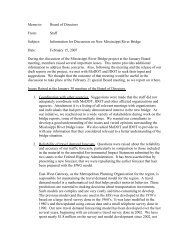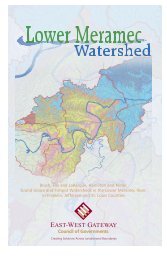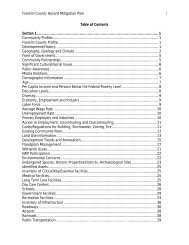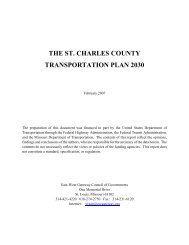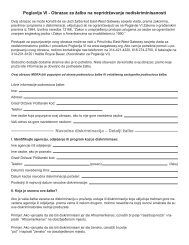Jefferson County - East-West Gateway Coordinating Council
Jefferson County - East-West Gateway Coordinating Council
Jefferson County - East-West Gateway Coordinating Council
You also want an ePaper? Increase the reach of your titles
YUMPU automatically turns print PDFs into web optimized ePapers that Google loves.
A Regional Overview All-Hazard Mitigation Plan<br />
SECTION 1<br />
Community Profiles<br />
Natural hazards impact not only the citizens of the <strong>East</strong>-<strong>West</strong> <strong>Gateway</strong> <strong>Council</strong> of<br />
Governments (EWG) planning region, but also their property, the environment and the<br />
economy. Natural hazards, defined here as flooding, windstorms, severe winter storms,<br />
earthquakes, heat waves, drought, dam failure and wildfires, have exposed the region’s<br />
residents and businesses to the financial and emotional costs of recovering after disasters.<br />
The risk associated with hazards increases as more people move to areas affect by hazards.<br />
The inevitability of hazards and growing population and activity within the planning region<br />
create an urgent need to develop strategies, coordinate resources and increase public<br />
awareness to reduce risk and prevent loss from future hazard events. Identifying risks<br />
posed by hazards, as well as developing strategies to reduce the impact of a hazard event<br />
can assist in protecting life and property of citizens and communities. Local residents and<br />
businesses are encouraged to work together to implement a Hazard Mitigation Plan that<br />
addresses the potential impact of hazard events.<br />
Below is a description and profile of <strong>Jefferson</strong> <strong>County</strong> within the EWG planning region.<br />
<strong>County</strong> Profile: <strong>Jefferson</strong> <strong>County</strong><br />
Development/History<br />
<strong>Jefferson</strong> <strong>County</strong> is located in eastern Missouri, just west of the Mississippi River. It is<br />
bordered on the north by St. Louis <strong>County</strong> and the Meramec River, on the south by Ste.<br />
Genevieve and St. Francois Counties, and on the west by Washington and Franklin<br />
Counties. The county is part of the St. Louis Metropolitan Statistical Area as defined by the<br />
United States Census Bureau. The county has an area of about 425,280 acres that includes<br />
about 2,176 acres of water in the Meramec, Mississippi and Big Rivers and other large<br />
impoundments. Interstate I-55 runs north and south through the county. <strong>Jefferson</strong><br />
<strong>County</strong> was separated from St. Louis and St. Genevieve Counties and established in 1818<br />
(effective January 1, 1819). Prior to settlement by Europeans, Native Americans including<br />
the Delaware, Missouri, Osage and Shawnee tribes inhabited the region. Charles III, the<br />
King of Spain, encouraged settlements by offering land grants. John Hildebrand,<br />
recognized as the first settler, settled on Saline Creek in 1774, later known as the Meramec<br />
Settlement. Lead, silica, zinc, barite, limestone and other mineral deposits lured settlers to<br />
the area. The first lead shot tower west of Pennsylvania was erected in 1809 in the<br />
southern part of Herculaneum. Sandstone mined from the St. Peter Sandstone Formation<br />
was used to manufacture glass. See Figure J1 in the back of the Technical Appendix.<br />
The county had a population of 200,101 as of the 2000 Census. There are 89,302<br />
registered voters in <strong>Jefferson</strong> <strong>County</strong> comprising 74.2 percent of the voting age population.<br />
1



